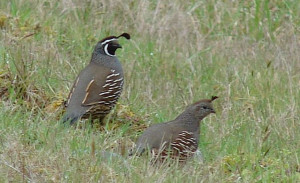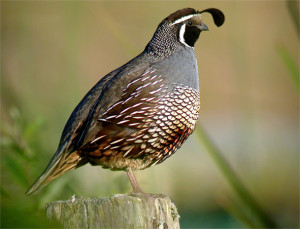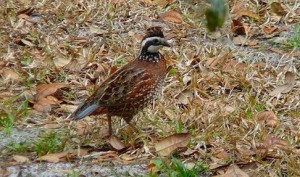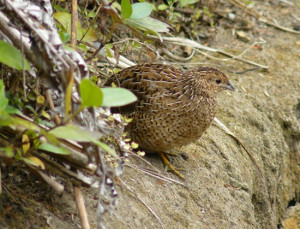Quail hunting is an exciting and demanding form of game bird hunting. Quail are small, fast flying birds, which means quick and accurate shooting is required.
Quail in New Zealand
The native New Zealand Quail was uncommon during early European settlement in NZ and considered extinct by about 1870. Californian quail were introduced to Nelson in 1865 and other parts of NZ soon followed. Today quail are the most common upland game bird in both the North and South Islands. New Zealand has three species of quail; california, brown and bobwhite. California quail are spread throughout New Zealand, while brown and bobwhite quail are more prevalent in the North Island. All can be hunted during the annual game bird season with a valid game bird hunting licence.
Please view more information on each species at the bottom of this page.
Quail Habitat
Habitat Quail are found throughout New Zealand but prefer semi-arid conditions. Coastal dune areas, exotic forests, scrubby shingle river beds and hill country are favoured habitat and quail are likely to roost in briar, broom, boxthorn, matagouri, manuka or gorse.
Hunting Quail
Quail are a challenge to hunt. They are noisy, ‘talkative’ birds making it easy to identify where a group or ‘covey’ may be resting but their rapid speed and small size make the shooting challenging.
An undisturbed covey will sit tightly on the ground or in bushes. When they are flushed by the hunter or by the hunter’s dog the birds explode quickly into the air. Often a rapid whirring of wings and a dark shape flying quickly past are the only indication that you have flushed a covey! When a covey is flushed it is very important that the hunter picks out individual birds to shoot and gives them plenty of lead. It is pointless to raise your shotgun and shoot blindly into the large covey flying quickly away. Quail do not fly long distances and will quickly return to ground where they re-group and sit tight, so exciting hunting can occur in a fairly small area.
Ideal weather conditions for quail hunting differ from that of duck hunting. Bright, warm and sunny days are the most productive as in these conditions the birds will be calling and moving about.
Gun Dogs
Gun dogs are an important asset when quail hunting. The birds are small and can be difficult to flush and find when they have been shot. Retrievers such as labradors and spaniels will flush coveys and retrieve shot game. Because quail hunters often have to cross harsh terrain it is important that dogs are fit and that their pads are frequently checked for thorns and splitting.
Equipment
Open choked shotguns are recommended in conjunction with number 7 or 8 shot. Due to the difficult terrain and warmer weather, quail hunting requires different clothing than waterfowl hunting - lightweight boots and clothing.
Because quail hunters often hunt in a group staggered across a line many hunters use a brightly coloured hunting vest or hat as a safety item. The vest also has plenty of room for ammunition and retrieved quail.
More Information
If you would like more information on quail hunting in your area, please click on the map above to select your local region. Here you can read all about local regulations and hunting spots and find contact details for your nearest Fish & Game office, who will be able to advise you with specific local requirements and recommendations.
Alternatively, you can contact the Fish & Game New Zealand Council on (04) 499 4767 or fax (04) 499 4768.
Quail Species


The native New Zealand quail was uncommon during early European settlement in New Zealand and considered extinct by 1870.
Californian quail were introduced to Nelson in 1865. Other provinces followed and populations expanded so rapidly that, in 1890, thousands of Californian quail were canned or frozen and exported from Nelson to London.
Later, the release of stoats and weasels for rabbit control took its inevitable toll and in some locations where quail were formerly numerous they disappeared completely.
However, quail are still the most common of the introduced upland game birds and are found in both islands.
In much of the North Island quail habitats overlap those of the pheasant. In the South Island, quail are found in all regions but there are fewer in Westland and coastal Southland.
Unlike pheasants, quail are gregarious and live together in coveys of between 10 and 100 with exceptional coveys of up to 400 Californian Quail being reported.
Coveys break up into breeding pairs in late winter and the first eggs appear in late September.
Nesting may continue through to February.
The nest is concealed in thick cover on the ground and up to 20 eggs may be laid.
After hatching the chicks are very active and are able to fly at three weeks.
The hunting season in most regions begins in May and continues until the end of August.

The least common of New Zealand upland gamebirds, the bobwhite was released from Auckland to Southland in 1898 and 1899.
Today their range is much reduced but small numbers of birds persist in South Auckland and Northern Hawkes Bay.
The populations of bobwhites are augmented with releases of hand reared birds by enthusiastic aviculturalists.

Brown quail were introduced to New Zealand as game birds in the 1860s and 1870s. However, the South Island liberations failed and now they are common only north of Auckland and in parts of the Bay of Plenty.
Their natural range is southern Indonesia, New Guinea, and Australia. It has been mooted that a species of the Australian brown quail was also native to New Zealand but the introduction of stocks of the same species from Australia makes it difficult to confirm.
The brown quail are an overall brownish colour, finely patterned with black and when scuttling for cover may be mistaken for a rat.
Rougher country is preferred with places to hide although, if pressed, will fly upwards with a whir of wings before landing in cover and quickly disappearing.